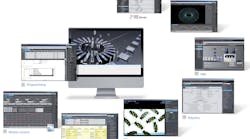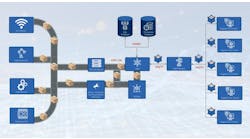How a robust data acquisition system helps manufacturers overcome challenges in quality assurance, high-precision assembly, flexibility, and labor availability
Today, manufacturers across industries face a number of critical challenges, including a need for consistent worldwide quality assurance, demand for “ultra-high-precision” assembly, a shortage of skilled workers, and consumer demands driving the need for flexible manufacturing. An Industry 4.0 digital transformation is often touted as the way to achieve stable quality assurance through large-scale, globalized supply networks; maintain a workforce that is relevant with today’s workflow yet flexible for future adaption; and achieve the flexibility to meet fluctuating consumer and market demand.
The automotive industry in particular must deal with large and complex production settings, and its companies suffer more than most from manufacturing pain points like unplanned downtime. Some of the common issues that automotive manufacturers experience are limited vendor choices, lack of sufficient information systems, poor communication between production lines, and inflexible network infrastructure. Furthermore, as new technologies are introduced, it can be challenging to keep production line and machine functional and updated while ensuring that workers are effective on the newest equipment. These issues are exacerbated when a manufacturer is using equipment belonging to multiple platforms.
Constantly jumping from one platform to another creates frustration, especially when the system fails to improve production or reduce costs. In this article, we will explore how to maximize the success of implementing new technologies with a robust operating system.
The challenge (and opportunity) of collecting impactful data
Manufacturers now have ways to connect machines, collect data and store that data. When you have a system that runs continuously and seamlessly connects all the devices you have in your plant, embracing new technology becomes simple and easy, and you can populate large amounts of information from a single device. However, the manufacturers that are gaining efficiencies despite the current challenges are the ones who understand how to analyze and visualize the data by moving the data up through vertical integration (in other words, taking the data from the shop floor through to their ERP systems). They are collecting impactful data.
To succeed at collecting impactful data, it is important to consider the value chain of information. It is often said that the price of survival is change, and all businesses must be able to change their value chain to utilize the data to find patterns, predict outcomes, and solve problems.
Understanding the value chain of information
The value chain of information consists of the following four steps: gathering data, understanding the data, communicating the data, and taking action on the data. To prepare for each step, first make sure that you are collecting clean and valuable data from the source, since you will need consistent metrics that provide insight into the voice of the process. There are several excellent tools and platforms that can help you do this. If the data is not consistent, reliable, and properly gathered in such a way that the context is maintained, it will be quite time-consuming to make it viable again, and it will slow down your efforts to implement new technologies and identify issues.
Secondly, in order to analyze and visualize the data, it must be delivered and presented to the right people at the right time with the right format. Analyzing and displaying viable data will empower your business to take action more quickly and with more confidence. When it comes to data contextualization, the most important thing is to filter out normal operation noise. This leaves process signals that help identify the root cause of issues while allowing production equipment to continue running. Process signals have the ability to fundamentally change your business’s problem-solving perspective and build a data-based corporate culture.
A data-focused approach to selecting an all-in-one platform
By being data-focused when selecting a single platform, manufacturers can leverage turnkey technology that is relatively simple to scale up across production machines when necessary, eliminating the need for future replacement of data sources or operation setting. The benefits of using an all-in-one operation platform include easy integration and a measurable return on investment. The timing of implementation is critical, given that if a database takes too long to become effective, a business might miss the opportunity to monetize the value of the data.
With an all-in-one operation system, you can remove computers from each station and install artificial intelligence (AI)-enabled controllers instead. These controllers collect information in real time and transfer it to a central location where it can be analyzed and visualized. Their communications capabilities help reduce installation time so that production managers, engineers, and maintenance managers can access the central depository in real time to collaborate quickly, further empowering decision-making.
By understanding the value chain of information and selecting an all-in-one platform that simplifies data collection and facilitates scalability, manufacturers can harness impactful data to make better decisions in real time. A single, all-in-one platform maximizes the ability of new technologies to work seamlessly together and makes it easier to add functionality in the future.





